ISSN ONLINE(2278-8875) PRINT (2320-3765)
ISSN ONLINE(2278-8875) PRINT (2320-3765)
Anoop.K.J1, Inbaezhilan2, Sathish raj3, Ramaseenivasan4, CholaPandian5
|
| Related article at Pubmed, Scholar Google |
Visit for more related articles at International Journal of Advanced Research in Electrical, Electronics and Instrumentation Engineering
This project describes the design of a voice controlled wheelchair and home appliances using embedded system. Proposed design supports voice activation system for severely disabled persons incorporating manual operation with switch. PIC Microcontroller (16F877A) and voice recognize processors (HM2007) were used to support the wheel chair and home automation. This is a unique system incorporating both wheel chair control through voice and the home automation which provides reliability, safety and comfort
Keywords |
||||||||||
| Wheel chair, PIC Microcontroller, HM2007, Voice Command, Interfacing Circuits | ||||||||||
INTRODUCTION |
||||||||||
| The idea of using voice activated technology for controlling the motion of the wheelchair and home automation are to prove that it can be a unique concept that would stand apart from the rest of the average projects. The use of this new technology in conjunction with a mechanical system in order to simplify everyday life and it would spark interest in an ever growing modern society. Many people with disabilities do not have the dexterity necessary to control a switch on an electrical wheelchair. This can be a great for the quadriplegics who is permanently unable to move any of the arms or legs. They can use their wheelchair easier only using voice commands and also they can control home appliances. The aim of this study is to implement an interesting application using small vocabulary word recognition system. The methodology adopted is based on grouping a microprocessor with a speech recognize development kit for isolated word from a dependent speaker. The resulting design is used to control a wheelchair and home appliances for a handicapped person based on the vocal command. In order to gain in time design, tests have shown that it would be better to choose a speech recognition kit and to adapt it to the application [1-2]. | ||||||||||
| Research from University of Notre Dame, 2000, suggests that the current power wheelchair control interfaces used may not, be adequate to provide truly independent mobility for substantial number of person with disabilities. The Respondents to the survey reported on average that approximately ten percent of the patients trained to operate a power wheelchair cannot use the chair upon completion of training for activities of daily living or can do so only with extreme difficulty (Linda Fehr, 2000). The data of the patients is given inthe table 1. From the table, we can see the list of the main types of control interfaces employed by power wheelchair users and the adequacy of these controls. The challenge for engineering is to provide safe and effective mobility in a dynamic environment. Through thoughtful research and design, power wheelchair & home appliances control will progress along safe and effective pathways towards providing users independent and self-guided mobility. In the wheelchair speech processing can be done in real time and has long been considered as a natural to assist powered wheelchair user and also the disabled peoples are require help in order to overcome physical challenges. Thus this project will provide an alternative to the disabled people in controlling the motion of the wheelchair using their voices and the efficiency of using voice controlled wheelchair can be identified. | ||||||||||
 |
||||||||||
| The main objective of the project is to design and implement a wheelchair for disabled a person which is controlled by the voice of user or by switch in case voice kit gets fail. There are seven conditions for basic motion of the wheelchair and control of home appliances to be applied by the user. Such as moving forward-backward, turning right-left, static or stop and light on and off. | ||||||||||
II. BLOCK DIAGRAM |
||||||||||
| A. Block Diagram of Voice Controlled Wheel Chair | ||||||||||
| In fig 1, the operator gives voice as input in order to drive the wheelchair to the desired position. Mic which converts the voice signal to the electric signal and the signal is given to the voice recognition module. The voice recognition module converts the analog signal into digital signal and the signal is transferred to the pic microcontroller. The microcontroller will take the decision to move forward or backward or left or right with help of relay switching unit | ||||||||||
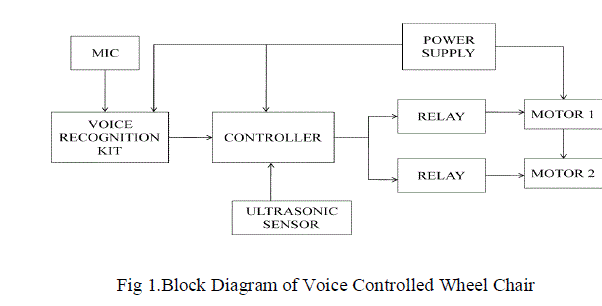 |
||||||||||
| B. Block Diagram of Voice Controlled Home Appliances | ||||||||||
| In fig 2, the operator gives voice as input in order to drive the wheelchair to the desired position. Mic which converts the voice signal to the electric signal and the signal is given to the voice recognition module. The voice recognition module converts the analog signal into digital signal and the signal is transferred to the pic microcontroller. The user can operate fan& light as per the requirement with help of relay switching unit. | ||||||||||
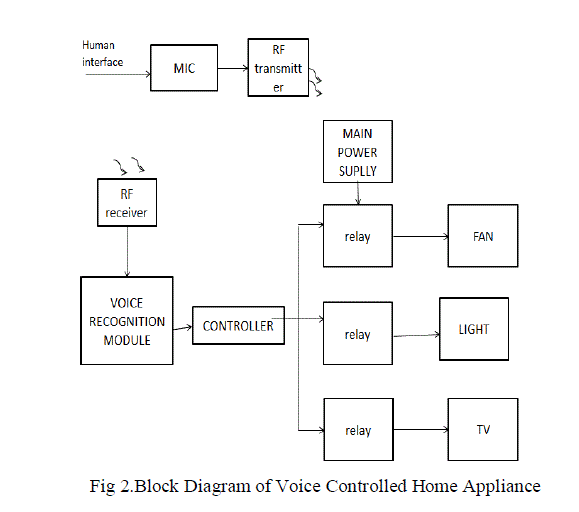 |
||||||||||
C. Flow Chart for System Design |
||||||||||
| A flowchart is used as diagrammatic representation of the problem and also provides a complete solution in analyzing, designing, work process or program. The flowchart for system design is shown in Fig 3. | ||||||||||
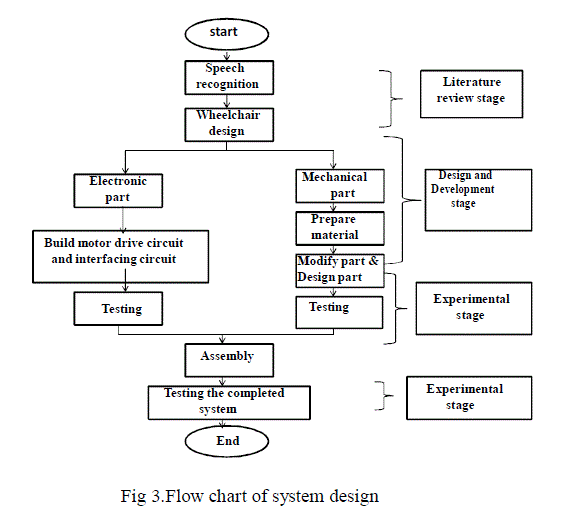 |
||||||||||
| The main part of the design is to control the motion of the wheelchair. There are four condition of motions are considered, moving forward, moving in reverse direction, moving to the left and moving to the right. For the speed, the user may use slow or fast speed command. The system starts by applying the supply voltage to the speech recognition circuit. For fast condition the system will supply higher current to the motors. If the user does not want the wheelchair move in high speed, the slow speed command can be set by applying low current supply to the motors. | ||||||||||
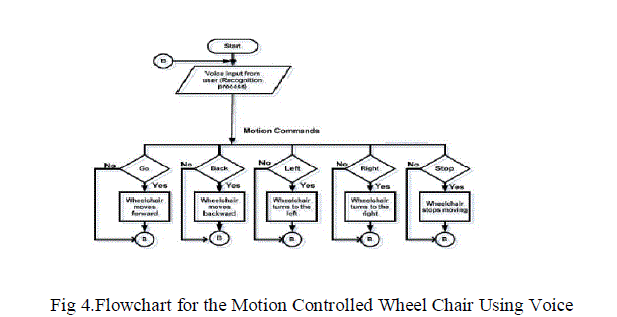 |
||||||||||
| The direction and speed of wheelchair depends on the user. Forward command the wheelchair move in forward direction. For the reverse direction the opposite movement of wheel rotation will occur. | ||||||||||
D. Voice Command |
||||||||||
| The left command will make right wheel moves forward and left wheel moves backward. The right command makes left wheel moves forward and right wheel rotate backward. In this system, by assigning the word command stop the rotation of both motors will stop. The wheelchair system will go back to the stand by condition or end the whole system by turning off the power supply of the speech recognition board. The voice commands used are as the table 2 shown below. | ||||||||||
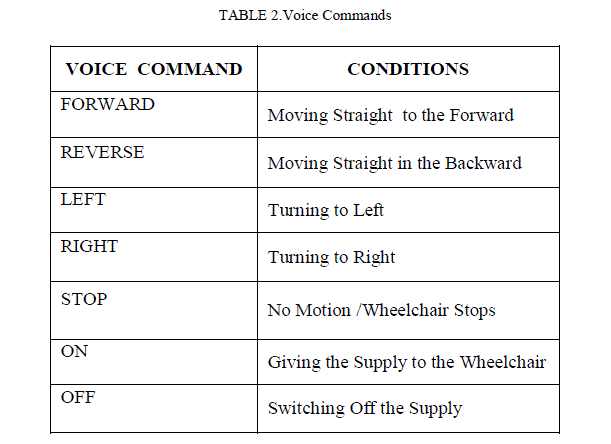 |
||||||||||
III. CIRCUIT DIAGRAM |
||||||||||
| The fig 5 shows that circuit of basic PIC connection which was connected through 16MHZ crystal oscillator through the pin 13 and 14 .The reset switch is connected to the through the pin 1. | ||||||||||
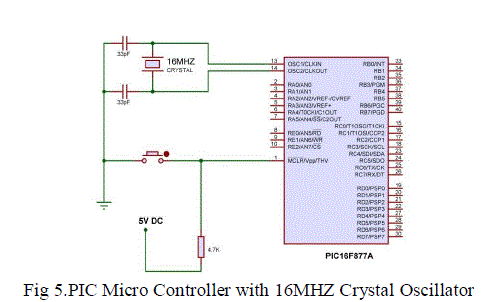 |
||||||||||
E. Power Supply |
||||||||||
| The power supply circuit is shown in fig 6. The ideal voltage required for the PIC16F877A is 5V.it should not be higher than the 5.5V because it going to blow up. It should not less than 2V. Using LM7805 constant 5V is given to the PIC and also LM7812 is used in the power supply unit to charge the battery. In PIC +5v given to the pin 11, 32 and also 12 and 31 pins are grounded | ||||||||||
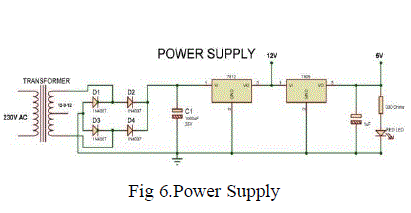 |
||||||||||
F. HM2007 (Voice Recognition Kit) |
||||||||||
| HM2007 is a single chip CMOS voice recognition LSI circuit with the on-chip analog front end, voice analysis, recognition process and system control functions. A 40 isolated-word voice recognition system can be consists of external microphone, keyboard, 64K SRAM memory combined with the microprocessor. | ||||||||||
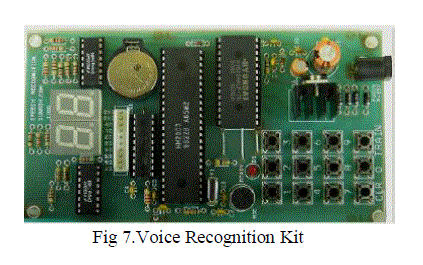 |
||||||||||
| The speech recognition system is a completely assembled and easy to use programmable speech recognition circuit. Programmable, in the sense that you train the words (or vocal utterances) you want the circuit to recognize. This board allows you to experiment with many facets of speech recognition technology. It has 8 bit data out which can be interfaced with the pic microcontroller for control the motor direction. | ||||||||||
G. Circuit for Motor Interfaced withPIC Using Relay Driver UL2003A |
||||||||||
| In the project the motors are controlled through the relays which as connected through UL2003A. To operate the relay the output current from the microcontroller is not sufficient to actuate the relay so the IC UL2003A is used to amplify the output current of the microcontroller. Thus the relays can be actuated to control the motor. | ||||||||||
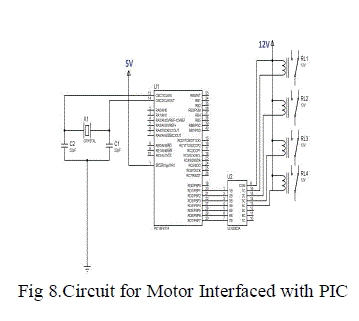 |
||||||||||
| H. Transmitter Receiver Circuit | ||||||||||
| HT12E Encoder IC will convert the 4 bit parallel data given to pins D0 – D3 to serial data and will be available at DOUT. This output serial data is given to RF Transmitter. Address inputs A0 – A7 can be used to provide data security and can be connected to GND (Logic ZERO) or left open (Logic ONE). Status of these Address pins should match with status of address pins in the receiver for the transmission of the data. Data will be transmitted only when the Transmit Enable pin (TE) is LOW. 1.1MΩ resistor will provide the necessary external resistance for the operation of the internal oscillator of HT12E.RF Receiver receives the data transmitted using RF Transmitter. HT12D decoder will convert the received serial data to 4 bit parallel data D0 – D3. The status of these address pins A0-A7 should match with status of address pin in the HT12E at the transmitter for the transmission of data. 47KΩ resistor will provide the necessary resistance required for the internal oscillator of the HT12D. | ||||||||||
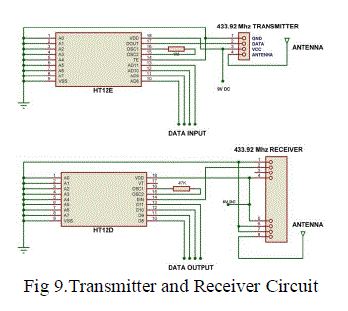 |
||||||||||
IV. HARDWARE RESULTS |
||||||||||
| The manual wheel chair has been designed to be an electrical wheelchair with the interfacing circuits. It uses a wheelchair motor which was specially designed for the purpose to move the wheelchair with a load. The wheelchair motors normally have high torque and high revolution per minutes (rpm). The fig 10 shows the hardware design of the wheel chair with the required interfacing circuits. | ||||||||||
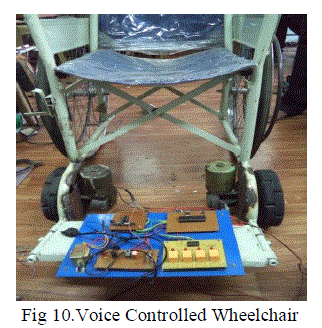 |
||||||||||
V. CONCLUSION |
||||||||||
| In this paper the design and implementation of a voice controlled wheelchair for disabled people using voice recognition processor HM2007 as well as switch control for acquiring and distinguishing the command for controlling the motion of a wheelchair & home appliances is shown. The direction of the wheelchair now can be selected using the specified voice commands or switch. The person sitting in the wheel chair can operate the home appliances (ie., Switching ON and OFF) through voice commands without moving.The design not only reduce the manufacture cost compared with present market but also will give great competitive with other types of electrical wheelchair. This project has many advantages like safety, comfort, energy saving, full automation etc. Thus a trained voice is only needed to ride the wheelchair. The future design can be improved by implementing wireless communication in the wheel chair. By improving this system, we directly enhance the life style of the disabled people in the community. | ||||||||||
Tables at a glance |
||||||||||
|
||||||||||
Figures at a glance |
||||||||||
|
||||||||||
References |
||||||||||
|